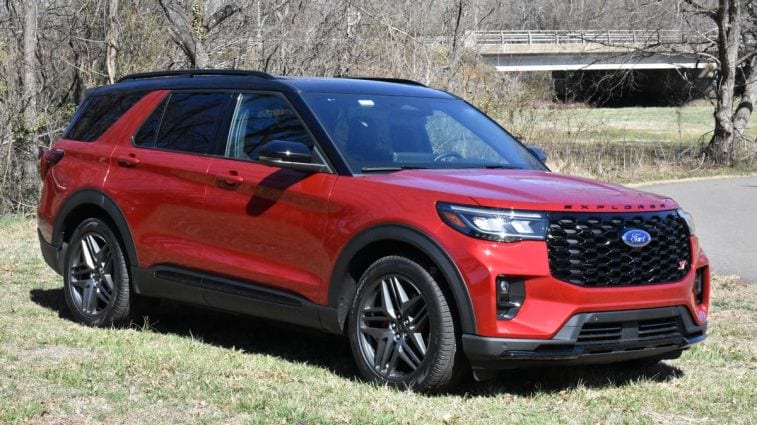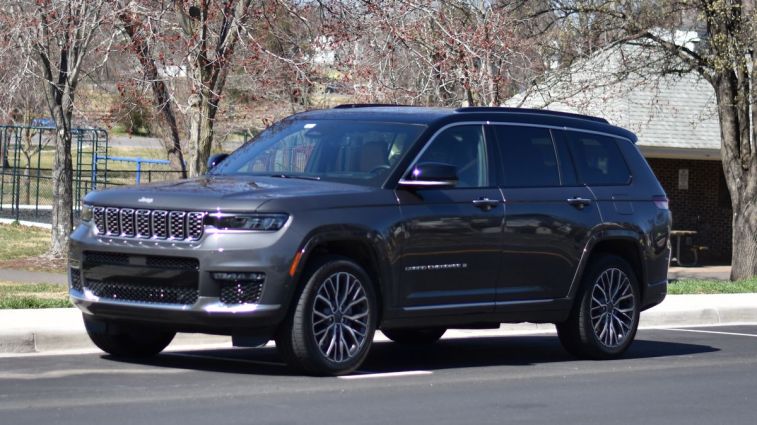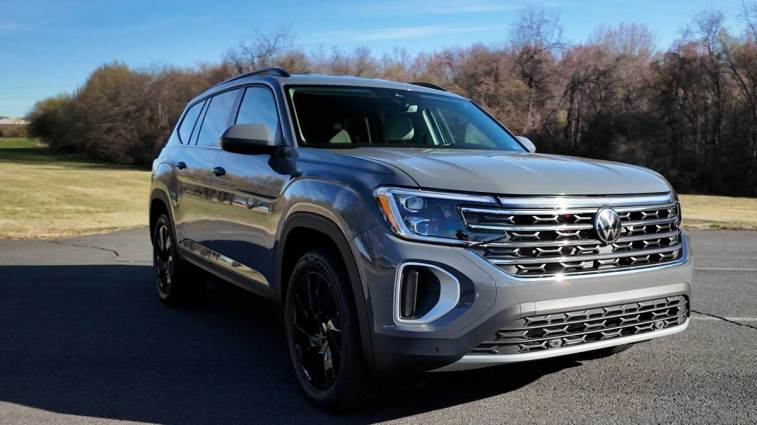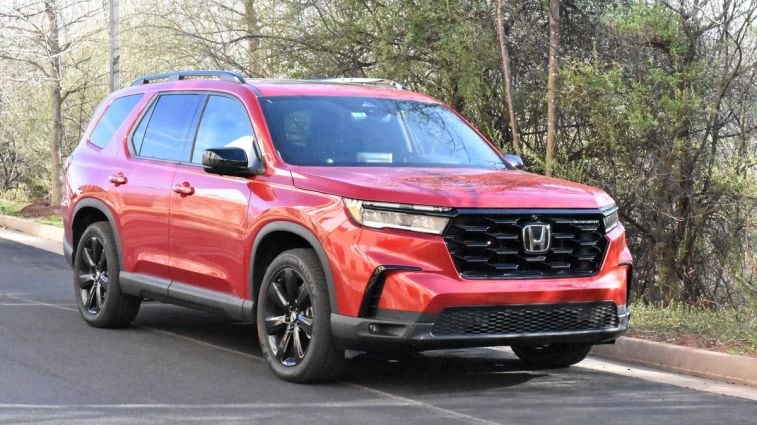The midsize 3-row SUV has grown in recent decades to be America’s preferred way of transporting families. If you need or want more than five seats and prefer the aesthetics of an SUV over a roomier minivan, then you’ll find what you’re looking for in this increasingly diverse class.
Our editorial team recently gathered in Virginia to compare several midsize 3-row SUVs back-to-back. The Kia Telluride is our Best Buy Award winner in this class, but the competitors we had available were (in order of sales volume) the Ford Explorer, Honda Pilot, Jeep Grand Cherokee L, and Volkswagen Atlas. After miles of driving and deep discussions, we determined how they rank against each other based on their strengths and weaknesses.
These SUVs are quite good from fourth place to first. Depending on your wants and needs, one that’s lower on the list might be the perfect SUV for you. Our goal is to rank these four SUVs in order of which is best for the most people shopping in this class.
We’ve covered every caveat, so let’s proceed with the rankings.
4th Place: Ford Explorer

A Great Engine in an Okay SUV
We should mention at the outset that the Ford Explorer we tested for this comparison was an Explorer ST. ST stands for “Sports Technologies.” In this case, those technologies include a muscular 400-horsepower turbo V6 engine, brake and suspension upgrades, and an appearance package to match its performance.
We can’t wait to tell you how it drives, so let’s start there. This kind of performance in a 3-row SUV is normally reserved for a more expensive luxury vehicle. The mighty 400-horsepower Explorer ST is a blast to drive fast, but also agreeable in more sedate everyday driving. The brakes and suspension are tuned just right to balance sporty performance with family-friendly comfort. However, we found the steering surprisingly un-sporty. Editor Russ Heaps quipped that this otherwise fun SUV “steers like a 50-year-old milk truck,” which we don’t think is what Ford was going for.
The Ford Explorer was notably the only SUV in this comparison with a hands-free driving option, BlueCruise. BlueCruise allows hands-free driving on more than 130,000 miles of North American highways mapped by Ford. We’ve been impressed with this feature every time we’ve tested it, and it keeps getting better with little things like moving over a little bit when it can tell you’re passing a semi-truck on the highway.
The enthusiast in us feels a little weird putting the vehicle with the best engine and the most entertaining driving experience at the last position on this list. But remember, we’re determining the best SUV for the widest range of people. Unless you’re specifically looking for a practical 3-row SUV that’s also a hoot to drive, the Explorer simply ain’t it.
The Explorer ST is pricey. It starts at $55,835, and our tester was in the mid-$60K range once options were added. Even considering how good the engine is, we found it overpriced. If you didn’t know a Ford Explorer could get that expensive, don’t worry; the base model starts in the low-$40K range.
Such a lofty price tag could be forgiven with a nice enough interior, but we agreed the Explorer’s interior felt the cheapest of the bunch. It has some nice design flair; we like the way the B&O premium audio system is neatly integrated into the dash. But sit in any of the back seats, and you won’t feel like you’re sitting in a vehicle with a $60,000-plus price tag. There’s too much hard plastic, the seat comfort is just okay (editor Nelson Ireson found the driver’s seat uncomfortably narrow), and it lacks physical HVAC controls (at least there’s a volume knob).
We climbed into the third row of the Explorer, and it was downright punishing. There was a noticeable lack of padding in the seats compared to the other three, and the floor height was such that we were squatting with our knees seemingly way up in the air. Also, the cupholders were weirdly low to give the Explorer a little extra cargo width when those seats are folded down. Speaking of which, the Explorer has the least cargo room in this comparison.
Wasn’t there anything we liked about this interior? Yes, we like the infotainment system. An update for 2025 brings a 13.2-inch display with what Ford calls the Ford Digital Experience. In addition to wireless Android Auto and Apple CarPlay, you can access apps and services from Google and Amazon, such as games and video streaming apps. It’s feature-rich, and it gets the basics right.
But another aspect working against the Explorer that put it at the bottom of this list is below-average resale value. It would be easier to recommend if it made more financial sense, but it’s not especially inpexpensive and doesn’t hold its value all that well.
Check this week’s Fair Purchase Price or see the Explorer models for sale near you.
3rd Place: Jeep Grand Cherokee L

Rugged and Premium
Honda has Acura, Volkswagen has Audi, and Ford has Lincoln. Jeep, however, doesn’t really have a luxury brand counterpart, as Chrysler is in a comatose state of exclusively selling a minivan from 2017 under two different names. Since the car-buying public is fine with paying big bucks for a Jeep, parent company Stellantis markets bona fide luxury SUVs under the Jeep banner. That’s what we’re looking at here with the Jeep Grand Cherokee L Summit Reserve. Starting at $67,035, the Grand Cherokee L Summit Reserve has the highest starting price of any trim of the SUVs we tested.
Although the Grand Cherokee L can be had for a modest price, starting in the low-$40K range, the loaded Summit Reserve model we tested is a genuine luxury SUV. When we climbed into the massaging Palermo leather seats with tasteful quilted stitching, we instantly felt like we were in an SUV from a luxury brand. This cabin is full of premium materials and modern tech features. The Uconnect infotainment system is one of our favorites in this class, and we welcomed the redundant physical controls for audio and climate settings. Stellantis vehicles have heated/ventilated seat controls hidden in the screen, but this one also has buttons. One gripe: The row of buttons mounted above the screen is hard to see.
Our tester was equipped with the sublime McIntosh 19-speaker audio system, which sounds as beautiful as it looks. There are lots of reminders that you sprung for the McIntosh, like expensive-looking speakers in the dash with “McIntosh” branding and illuminated “McIntosh” logos in the rear door speaker grilles. This is simply one of the best car audio systems we’ve ever tested; a must-have upgrade for audiophiles.
Driving the Jeep Grand Cherokee L Summit Reserve is a delight. The V6 under the hood delivers predictable power, and the sophisticated Quadra-Lift adaptive suspension system soaks up road imperfections and ensures stable steering. Editor Scott Hinderer noted that the Jeep “felt stable with little body roll through a series of S curves that could have constituted a slalom course” and that the “steering and suspension felt great.” Jeep also says this optional suspension system improves off-road capability, but that wasn’t part of our testing process. In our experience driving the Grand Cherokee L with the standard suspension on the more affordable trims, ride quality is good but not exemplary like it is here.
This had the nicest and most comfortable second-row seating, with a nice center console. But the catch with the Grand Cherokee L is what’s behind the second row. A good tilt-and-slide system for the second-row captain’s chairs makes the third row fairly easy to access, but there’s not much room back there. Some of the fanciness of the Summit Reserve is diminished when you’re crammed into that little third row. This was surprising, considering the 204-inch overall length of the Grand Cherokee L makes it one of the biggest SUVs in this class.
The small third row would be more forgivable if there were a lot of cargo room behind it, but there’s not. That said, we were pleasantly surprised that this Jeep has a completely flat load floor with all of the seats folded down, even with that second-row center console. It has a lid that opens from behind, and it flips all the way over to cleverly create a flat load floor. However, someone who had this before us was using it to haul tires, and there were noticeable marks and scuffs on the lovely Tupelo-colored leather upholstery. This fancy interior can’t take a beating the way its more minivan-like rivals can.
The upscale interior and refined driving experience make the Jeep Grand Cherokee L Summit Reserve a lovely luxury SUV, but its small third row and cargo hold make it just okay as a family hauler. This same SUV is available as the non-L, 2-row Grand Cherokee for $2K less, and we couldn’t help but wonder if that would make more sense for most people in the market for an SUV like this. It’s an absolutely lovely way to transport four or fewer people, so why bother with the third row when a more affordable 2-row option is available?
Resale value, fuel economy, and starting price are all about average for the Jeep Grand Cherokee L. As a financial decision, you could do better, and you could do worse.
Check this week’s Fair Purchase Price or see the Grand Cherokee L models for sale near you.
New 2025 Jeep Grand Cherokee L Prices
|
Retail Price
|
Fair Purchase Price (43085)
|
|||
|---|---|---|---|---|
$41,030 |
$39,314 |
|||
$41,530 |
$39,794 |
|||
$45,635 |
$43,727 |
|||
$46,135 |
$44,206 |
|||
$46,900 |
$44,939 |
|||
$60,990 |
$58,440 |
|||
$62,555 |
$59,627 |
|||
$67,035 |
$63,897 |
2nd Place: Volkswagen Atlas

The Best Third Row
If we were to choose one SUV to sit in the third row for a cross-country road trip, we’d pick the Volkswagen Atlas. Comparing the interior dimensions on paper, the Atlas has the most third-row legroom and the most cargo space in this comparison, and climbing around in it confirmed what a difference that extra space makes.
When a couple of us went for a ride in the third row, we expected to be eager to get out, as is often the case in this class. But this third row is genuinely comfortable for normal-sized adults. We also appreciated that each side gets three cupholders, one of which is oddly small, but the other two are perfectly soda-can-friendly. Maybe the tiny one is for when you give your kids a Red Bull on the way to Grandma’s.
The Atlas has a maximum seating capacity of seven, while some rivals can accommodate eight. That’s because Volkswagen decided not to bother with a middle third-row seat, which we applaud. That middle seat in the way back of a midsize SUV is usually useless. By forgoing it, the Atlas gives the two passengers in the third row much more hip room. We can confirm that two adult men can sit back there without needing to cuddle.
Did we mention that there’s actually usable cargo space behind the third row? The Atlas is the cargo space leader in this comparison. It has 20.6 cubic feet of room behind the third row, which is 10% more than the Pilot with the next biggest cargo hold.
So, with all of that interior space, why isn’t the Volkswagen Atlas the victor of this comparison? Well, when we got behind the wheel, we were pleased with the quality of the materials and the upscale yet conservative design befitting a sophisticated German vehicle, especially since this SE w/ Tech Package had the lowest sticker price in our comparison at $45,020 as tested.
But as soon as we started playing with the controls, like trying to make the satellite radio work and adjust the climate control, we got frustrated. The Atlas has the steepest learning curve for the user interface for things like the infotainment system, climate control, and other essential functions. There’s no volume knob (when will they learn?) and no hard knobs, buttons, or switches for the climate control. Everything runs on the unintuitive touchscreen and frustrating touch-sensitive controls. Tapping (and sometimes shouting) at the piano black trim with little pictures on it just isn’t as easy or satisfying as physical controls. It’s nigh impossible to make these adjustments while keeping your eyes on the road. The steering wheel controls aren’t much better.
Luckily, things got better when we actually started driving. With its most recent refresh, the Atlas ditched its former V6 and turbo 4-cylinder options for one new turbo-4, and we like it. Its claim to fame is more torque and better fuel economy than the outgoing V6, and our testing proved that claim right. This is also one of the more refined 4-cylinder engines in this class, without too much noise entering the cabin.
Resale value is another notable weakness; the Atlas’s residual value is the lowest in this comparison. However, if you’re planning on keeping it for a long time, this isn’t as big of a problem.
If you prioritize a big interior, can get past the learning curve of the frustrating controls, and don’t mind subpar resale value, the Atlas might be your family’s next ride.
Check this week’s Fair Purchase Price or see the Atlas models for sale near you.
New 2025 Volkswagen Atlas Prices
|
Retail Price
|
Fair Purchase Price (43085)
|
|||
|---|---|---|---|---|
$39,625 |
$37,552 |
|||
$41,525 |
$39,672 |
|||
$43,730 |
$41,696 |
|||
$45,630 |
$43,467 |
|||
$48,080 |
$45,969 |
|||
$49,625 |
$47,510 |
|||
$54,630 |
$52,575 |
1st Place: Honda Pilot

Minivan in Disguise
Let’s face it: Just about everyone who buys a midsize 3-row SUV would be better off with a minivan. But we can understand the preference for the aesthetics of an SUV. With that in mind, the Honda Pilot does the best minivan impression of the four SUVs we tested, putting it in the top spot in our rankings here.
The Honda Pilot doesn’t have the most premium interior, and it doesn’t even have the most space. What it does have is the most thoughtfully designed and family-oriented cabin of these four rivals. One of our favorite features is the removable middle seat in the second row. We were able to pop the whole thing out with no tools required, and we could even stow it under the rear cargo floor. This class-exclusive feature gives the Pilot the comfort of second-row captain’s chairs with the convenience of an eighth seat if you need it in a pinch.
We found the third row fairly easy to get in and out of, and Honda did a good job integrating little steps like running boards to make ingress and egress for kids easier. Once we were settled in, we found adequate legroom, two large cupholders per side, and a USB-C port on both sides. However, that middle third-row seat is awfully narrow, even for kids.
Although there’s quite a bit of plastic in this interior, Honda does a nice job of not making it feel cheap. Just think about how easy it will be to clean when muddy shoes, dog hair, and spilled beverages ravage the interior. Balancing out the plastic appointments are surprisingly high-quality and comfortable leather seats in the Black Edition tested, which starts at $56,030. A couple of family-friendly touches borrowed from the Odyssey minivan include the CabinTalk intercom and CabinWatch interior camera system. However, editor Scott Hinderer pointed out that the piano black interior trim “will scratch and smudge easily, especially in such a high-touch area.”
Speaking of the Black Edition, we dig the black exterior trim, the black wheels, and the red interior stitching, but we’d rather save a few bucks and go with the similarly equipped Pilot Elite. If that’s a little out of your budget, don’t worry; the Pilot is terrific regardless of trim.
So, the interior does the living room-on-wheels thing brilliantly, but how does it actually drive? There are no surprises when piloting the Pilot, and we don’t think that’s a bad thing. The tried and true Honda V6 under the hood delivers confident acceleration, while the chassis provides a pleasant ride quality that’s comfy on long-distance drives. As much of this class migrates to turbocharged 4-cylinder engines, we find the grunt of the V6 quite satisfying.
The vehicle itself is something of a jack of all trades, but one area in which the Pilot is the master of this comparison is resale value. Based on our data, the resale value of the other three SUVs on this list is either average or below average. Meanwhile, the Honda Pilot is toward the top of its class with a well-above-average resale value. That means more money in your pocket when it’s time to sell or trade-in.
In our expert opinion, these strengths combine to make this the best SUV for most families in the market for a midsize SUV in this comparison.
Check this week’s Fair Purchase Price or see the Pilot models for sale near you.
New 2025 Honda Pilot Prices
|
Retail Price
|
Fair Purchase Price (43085)
|
|||
|---|---|---|---|---|
$41,650 |
$38,692 |
|||
$44,950 |
$41,619 |
|||
$48,950 |
$45,229 |
|||
$50,850 |
$47,036 |
|||
$54,530 |
$50,631 |
|||
$56,030 |
$51,771 |







